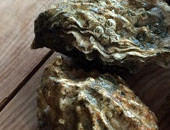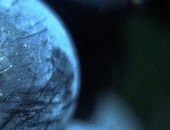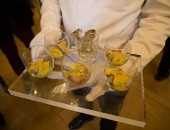We review wines from 2000 - 2009
To paraphrase Napoleon: in victory you deserve Champagne, and you should lay down the appropriate vintages for future anniversaries, according to your preference and marque of choice. In defeat, make sure you have a mature bottle in the cellar which may remind you of better times consistent with the house, style and vintage you prefer: you need it. The shorter version is rather more pithy, but lacks definition.
The Champenois' have done such a good job promoting themselves that the variety of styles and range of Champagnes is rather submerged in people's minds under the blanket name of the appellation - 'Champagne'.
What is 'vintage' Champagne?
To understand 'vintage' Champagne, it is best to start by comprehending the constituents of its 'non-vintage' (NV) counterpart. There is a perception amongst some that NV Champagne might be the same as a vintage bottle but that, for whatever reason, the 'vintage' was not 'declared' . But this is not the case - both wines are fundamentally different in their approach, content, style and objective. NV Champagne is a blend of wines harvested from different years, in different proportions and with the different grape varieties that identify the house style: it is often referred to as the 'soul' of the Champagne house - for it is the wine which everyone will associate with the brand. Vintage Champagne, on the other hand, is aged for longer, contains the harvest of one year only and will vary in style, texture, taste, depth and complexity depending on the characteristics of the particular vintage from which it is made. Under the rules which govern Champagne production a vintage wine must have at least 3 years of aging following the first bottling (NV is only 15 months) but many top Champagne houses age their wines for much longer releasing them on the market after many years of repose in their cellars. Whilst vintage wines are the natural expression of the weather during the year, the terroir which produced the grapes is to a greater or lesser degree capable of toning down its excesses.
Most people discover which Champagnes they prefer after drinking various marques, even if they don't know why they enjoy them the most. It is then that they may try the vintage and prestige cuvées which whilst preserving the profile of the Champagne house would, in the case of vintage Champagne, be tempered by the conditions of the particular season. The character of the wine will likely be stronger, which may not be to everyone's tastes, particularly to the neophyte Champagne drinker.
Creating a vintage Champagne
Generally speaking, in creating a vintage Champagne a producer is free from the shackle of managing the volume of wine it decides to produce. Note 1A complicating issue is the overall quantity of wine available to make vintage and non-vintage wine. This is a subject which could occupy a whole article - the context of the yield, reserve wines and so-called 'blocage'. If, for example, one takes 2012 which is potentially a good year despite its problems, where the quantity is low, a company like Lanson can make all of the vintage and special cuvées it may want but for the NV brut (which they will start to bottle in 2012) they will depend on the stocks of reserve wines. The importance of 'reserve' wines can't be stressed enough: for example, they must support the winemaker when the quality of the harvest is good but also when it is not so good. Different reserve wines will need to possess all of the character profiles which may be lacking from a particular year but are nonetheless required to make up the assemblage. For non-vintage wines, the banner of the Champagne house, a company will always have in mind the quantity of wine they would like to release onto the market - this is the wine, after all, which controls their profitability and continuing success. There are, of course, exceptions to this rule – for example, Dom Perignon, a vintage Champagne conceived in its own right. But for most companies the production of vintage Champagne is fairly small and the objective has nothing to do with the quantity of wine they wish to make but rather a desire to achieve a wine which encapsulates the potential from a harvest given the dictates of the season. Some houses are so compelled to fill their quotas of non-vintage Champagne that they have little wine left to make up any vintage selection. In years when the harvest is low and the quality is very good this may be a difficult balance to achieve - a Champagne house could have all the wine it needs to fulfill any number of quotas for vintage and special cuvées before even contemplating its NV output.
Vintage qualities
In the New Year following a harvest a producer will taste his or her cuvées to understand the inherent qualities of the wines. They will probably start with separating those that are the best and the worst. The former are the stocks which will make up the blends for the premium wines including vintage selections the latter will be excluded from any part of their wine-making process. A primary reason for selection is elegance. However, a producer will consider what kind of wine it is they wish to make: a wine true to the vintage or, perhaps, a wine made more in the house style or even, a combination of both. They will also assess the cuvées for their aging potential. The chosen wines should reveal a degree of precision, elegance and might even possess certain ineffable qualities – one winemaker described this as 'verticality' - a literal description of a link between the roots and the sky. The wines held in the cuvées which are already too expressive may be excluded because they have opened too much, too early – a winemaker is looking for something which will evolve in the future and an over-expressive wine may indicate that it has already peaked. As an example of an approach: when Lanson decide to make a vintage wine it must represent the profile of their founder's original concept for a vintage Champagne: rich, concentrated, and powerful wines made from equal proportions of Chardonnnay and Pinot Noir. The founder, Victor Lanson, always wished to make a vintage wine to accompany food (rather than, say, as an aperitif) and hence the stylistic components required in order to compliment food flavours. Despite this, the wine has considerable 'finesse'.
Whilst acidity is often regarded as a sine qua non of good aging for a wine, it is not always the case as the 1989 vintage in Champagne demonstrated: 1989 possessed a lower acidity than the years either side but has been slower to evolve contrary to the general rule. So, predicting a Champagne's future is not an exact science and cellar masters and experts have made mistakes. Although it is generally a truism that wines with a lower pH (higher acidity) are more often selected for vintage cuvées, along with greater fruit character and those exhibiting aging potential, anyone can get it wrong: sometimes a producer may think a wine will make a great vintage, and it doesn't, and also the reverse.
General comments on the vintages
We tasted wines from 2000, 2002, 2003, 2004, 2005, 2006, 2007 and 2008 vintages.
It is fairly clear from our tastings of the different vintages (albeit one is not comparing like with like e.g. different wines, different blends and different styles) that 2002 is an outstanding year, but there are still many houses who have yet to release their later vintages - 2005 and 2006 in particular - which are shaping up well. This does not stop a particular domain from making a truly remarkable wine in a year perceived as 'difficult', for example de Sacy cuvee Grand Soir Grand cru 2003. Running through the years, for which more detailed notes are available along with individual tasting notes (see related articles), general observations are: 2000 had some difficulties not the least of which was hail and maintaining the sanitation of the grapes during the year - its signature was light, fruity and less acidulous wines. 2002 was an exceptional year, with good alcohol levels and moderate acidity. 2003 was a good year which one might describe as 'fat' due to the heat in the summer so whilst there were lower levels of acidity the year provided a rare opportunity. 2004 was very good with excellent typicity; 2005 didn't match the conditions on the western side of France and although good it had its problems whilst the Chardonnay were exceptional - look out for blanc de blancs 2005. 2006 slightly lacks a little maturity in the Chardonnay and 2008 is considered an exceptional vintage across the board.
A good vintage Champagne will age gracefully for 10-30 years and longer if properly stored.
Favourite Champagnes
Please see the tasting notes on all the wines but these wines were truly exceptional:
- de Sacy cuvee Grand Soir Grand Cru 2003
- Besserat De Bellefon blancs de blanc Cuvée des Moines 2002
- Bruno Paillard 2002 brut
- Marguet blanc de noirs (2009) - not a true vintage wine however made with a majority of 2009.
- J Charpentier 2004
- Dom Perignon 2003
- Larmandier-Bernier 2005
- Lanson Gold Label 2002
- Duval Leroy brut nature 2002
- Gimonnet Special Club 2005
- Tsarine brut 2006
- Gosset Grand Vintage 2004
- Moncuit Grand cru blanc de blancs 2005
- Billecart-Salmon cuvée Nicolas Francois Billecart 2000
- Billecart-Salmon rosé 2002
- Marguet Grand cru blanc de blancs 2006
- Abelé sourire de Reims 2002
- Le Brun de Neuville blanc de blancs 2003
To paraphrase Napoleon: in victory you deserve Champagne, and you should lay down the appropriate vintages for future anniversaries, according to your preference and marque of choice. In defeat, make sure you have a mature bottle in the cellar which may remind you of better times consistent with the house, style and vintage you prefer: you need it. The shorter version is rather more pithy, but lacks definition.
The Champenois' have done such a good job promoting themselves that the variety of styles and range of Champagnes is rather submerged in people's minds under the blanket name of the appellation - 'Champagne'.
What is 'vintage' Champagne?
To understand 'vintage' Champagne, it is best to start by comprehending the constituents of its 'non-vintage' (NV) counterpart. There is a perception amongst some that NV Champagne might be the same as a vintage bottle but that, for whatever reason, the 'vintage' was not 'declared' . But this is not the case - both wines are fundamentally different in their approach, content, style and objective. NV Champagne is a blend of wines harvested from different years, in different proportions and with the different grape varieties that identify the house style: it is often referred to as the 'soul' of the Champagne house - for it is the wine which everyone will associate with the brand. Vintage Champagne, on the other hand, is aged for longer, contains the harvest of one year only and will vary in style, texture, taste, depth and complexity depending on the characteristics of the particular vintage from which it is made. Under the rules which govern Champagne production a vintage wine must have at least 3 years of aging following the first bottling (NV is only 15 months) but many top Champagne houses age their wines for much longer releasing them on the market after many years of repose in their cellars. Whilst vintage wines are the natural expression of the weather during the year, the terroir which produced the grapes is to a greater or lesser degree capable of toning down its excesses.
Most people discover which Champagnes they prefer after drinking various marques, even if they don't know why they enjoy them the most. It is then that they may try the vintage and prestige cuvées which whilst preserving the profile of the Champagne house would, in the case of vintage Champagne, be tempered by the conditions of the particular season. The character of the wine will likely be stronger, which may not be to everyone's tastes, particularly to the neophyte Champagne drinker.
.../continued...you need to upgrade your subscription if you wish to read this content.
To paraphrase Napoleon: in victory you deserve Champagne, and you should lay down the appropriate vintages for future anniversaries, according to your preference and marque of choice. In defeat, make sure you have a mature bottle in the cellar which may remind you of better times consistent with the house, style and vintage you prefer: you need it. The shorter version is rather more pithy, but lacks definition.
The Champenois' have done such a good job promoting themselves that the variety of styles and range of Champagnes is rather submerged in people's minds under the blanket name of the appellation - 'Champagne'.
What is 'vintage' Champagne?
To understand 'vintage' Champagne, it is best to start by comprehending the constituents of its 'non-vintage' (NV) counterpart. There is a perception amongst some that NV Champagne might be the same as a vintage bottle but that, for whatever reason, the 'vintage' was not 'declared' . But this is not the case - both wines are fundamentally different in their approach, content, style and objective. NV Champagne is a blend of wines harvested from different years, in different proportions and with the different grape varieties that identify the house style: it is often referred to as the 'soul' of the Champagne house - for it is the wine which everyone will associate with the brand. Vintage Champagne, on the other hand, is aged for longer, contains the harvest of one year only and will vary in style, texture, taste, depth and complexity depending on the characteristics of the particular vintage from which it is made. Under the rules which govern Champagne production a vintage wine must have at least 3 years of aging following the first bottling (NV is only 15 months) but many top Champagne houses age their wines for much longer releasing them on the market after many years of repose in their cellars. Whilst vintage wines are the natural expression of the weather during the year, the terroir which produced the grapes is to a greater or lesser degree capable of toning down its excesses.
Most people discover which Champagnes they prefer after drinking various marques, even if they don't know why they enjoy them the most. It is then that they may try the vintage and prestige cuvées which whilst preserving the profile of the Champagne house would, in the case of vintage Champagne, be tempered by the conditions of the particular season. The character of the wine will likely be stronger, which may not be to everyone's tastes, particularly to the neophyte Champagne drinker.
.../continued...you need to subscribe to be able to view content from Fine Wine magazine.
Subscribe HERE to Fine Wine magazine to read the rest of this content or log yourself below in if you are already a member and you will be returned to this page.
'%%previous%%')); ?>
References
| ↑1 | A complicating issue is the overall quantity of wine available to make vintage and non-vintage wine. This is a subject which could occupy a whole article - the context of the yield, reserve wines and so-called 'blocage'. If, for example, one takes 2012 which is potentially a good year despite its problems, where the quantity is low, a company like Lanson can make all of the vintage and special cuvées it may want but for the NV brut (which they will start to bottle in 2012) they will depend on the stocks of reserve wines. The importance of 'reserve' wines can't be stressed enough: for example, they must support the winemaker when the quality of the harvest is good but also when it is not so good. Different reserve wines will need to possess all of the character profiles which may be lacking from a particular year but are nonetheless required to make up the assemblage. |
|---|










